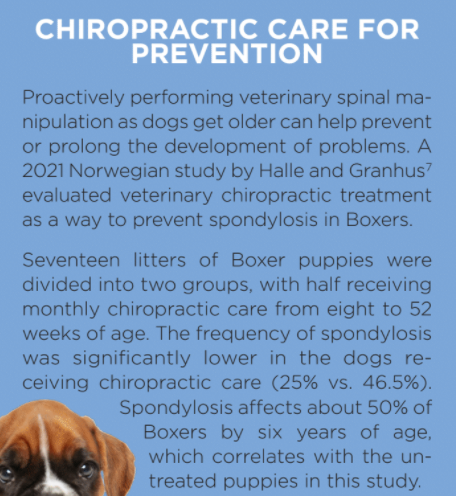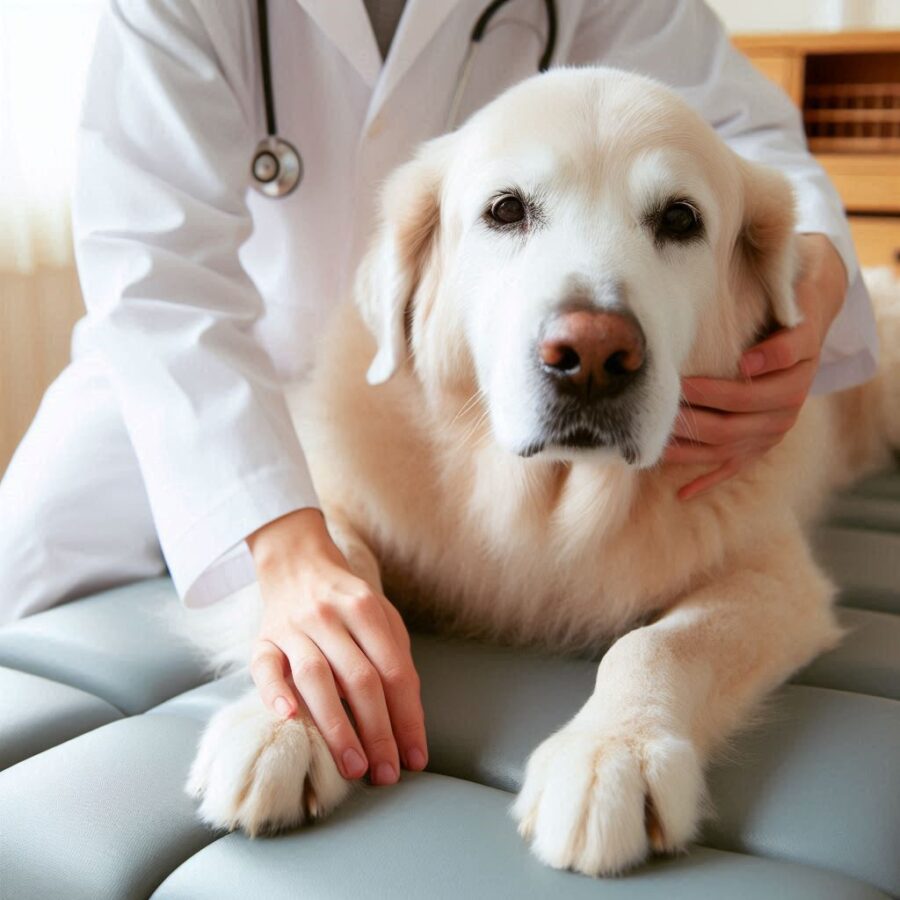Chiropractic care is an effective diagnostic and therapeutic modality for identifying and treating primary causes of musculoskeletal dysfunction in dogs.
Geriatric animals account for half of the pet population in the United States, and their numbers are increasing annually.1 Mobility limitations significantly decrease quality of life and shorten life expectancy for senior dogs. Dogs lacking mobility are predisposed to unwanted sequela, including decubital sores, urinary tract infections, skin infections, and pneumonia. Therefore, a major goal in optimizing geriatric health is to enhance functional movement. One way to achieve this is to use chiropractic care for improving mobility in aging dogs.
Veterinary spinal manipulation therapy
For centuries, spinal manipulation has been used in humans as a therapy to complement traditional medicine. Although not universally accepted as a standard treatment for dogs, chiropractic therapy is gaining more acceptance. The modern form of animal chiropractic became popular within the past century, and has been dubbed veterinary spinal manipulation therapy. The American Veterinary Chiropractic Association (AVCA) was founded in 1989.
Veterinary spinal manipulation therapy should be performed by a veterinarian trained in this modality. Many human chiropractors also perform spinal manipulations on animals and may be certified by the Animal Chiropractic Certification Commission. Animal chiropractors need to have specific training in both chiropractic technique and animal anatomy so they know the differences among species and how to best adjust the vertebrae.2
Chiropractic exam and adjustments
The chiropractic exam offers additional diagnostic and therapeutic means of identifying and treating primary causes of musculoskeletal disorders, compared to more traditional veterinary clinical approaches alone. It includes evaluating the patients history, intended use, athleticism, and health status, along with a neurological examination, stance and gait analysis, radiographs, and motion and static palpation.
Chiropractic adjustment is defined as short lever, high velocity, controlled thrust by hand or instrument directed at specific articulations to correct vertebral subluxations.3 When performed by a qualified practitioner, veterinary spinal manipulation has a lower incidence of injury or adverse reactions than many standard treatments or medications.
Subluxation
Subluxation occurs when the vertebrae are in abnormal positions or misaligned, resulting in altered physiologic functions of the spine and placing excessive pressure and inflammation on the spinal nerves. Left untreated, subluxation can trigger a degenerative process in the surrounding areas, including degenerative joint changes. Subluxations commonly occur due to traumatic events, poor conformation, lack of movement, overwork, or genetic boney issues. Loss of muscle tone due to aging or arthritis pain decreases the ability of the muscles to keep the spine aligned.
Emotional stress and chemical imbalances also contribute to spinal subluxations. Prescription drugs can have a negative impact on muscle and muscle tone. Calcium-deficient diets can be associated with muscle spasms that can impact spinal alignment. Environmental and food toxins cause chemical imbalances in the body that affect muscles and spinal alignment.
Five components create the spinal vertebral subluxation complex:
- Osseous component: This is where the vertebrae are either slightly out of position, not moving correctly, or undergoing degeneration.
- Nerve component: Improper spinal function irritates nerve tissue, causing symptoms in various parts of the body depending on the nerve affected.
- Muscle component: When the muscles supporting the spine tighten, weaken, go into spasm, or suffer from atrophy, a change in muscle tone results.
- Soft tissue component: Changes occur in the surrounding soft tissues, such as the tendons, ligaments, and blood supply when vertebrae are misaligned and theres pressure on the nerves.
- Chemical component: Biochemical abnormalities will occur in organs and tissues depending on which area of the body is being affected by the spinal misalignment.3

Symptoms of Subluxation
The symptoms of subluxations are varied. They can include chronic pain, swelling, limited mobility, unwillingness to move, irritation or aggression, trouble climbing stairs, limping, weakness, inability to jump, sitting in an abnormal position or tilted to the side, abnormal gait with shortened stride, hunched back, or crying. Other changes can include digestive and bowel issues, dragging feet, incontinence (both bowel and bladder), muscle atrophy, pockets of congestion where toxins build up in muscles, edema or fluid retention, fibrosis or scar tissue in the muscles, blood pooling in the muscles from decreased blood circulation, lack of blood flow to muscles due to spasms, minute hemorrhages, and tissue rigidity.
How chiropractic adjustment helps senior dogs
Chiropractic adjustment can be beneficial for senior dogs with:
- Osteoarthritis
- Intervertebral disc disease
- Degenerative myelopathy
- Spondylosis
- Cruciate tears
- Any inflammatory or degenerative condition.
The goal of chiropractic treatment is to restore normal joint mobility, improve flexibility, and reduce pain and muscle tension. Ensuring normal range of motion of the vertebrae can increase the function of the lymphatic and circulatory systems and help clear toxins from the body. This therapy can be very useful in alleviating pain caused by chronic disease.
Restoring nerve function
At every vertebral space, nerves exit and enter the spinal column. The nerves carry impulses from the brain to the internal organs, muscles, joints, and skin, and transmit information from all areas of the body back to the brain. When the vertebral joints do not have a full range of motion, the nerves become irritated. The chiropractors job is to detect those areas that have lost motion. A chiropractic adjustment restores mobility and allows the nerve impulses to transmit freely. A chiropractor moves through each joint, restoring the range of motion, allowing the nervous system to function at full capacity. The chiropractor will work on all spinal joints, as well as joints in other areas of the body, relieving tension on the nerves and increasing blood supply to the area.
The results of chiropractic adjustment
Following an adjustment, geriatric dogs usually seem less stiff and painful. They may show improvements in gait, activity, and stamina. While some may show improvement immediately after an adjustment, others may take days or weeks, depending on the severity and length of time the subluxations have been present. Other problems associated with aging may also resolve after chiropractic care, including urinary and fecal incontinence, nervous licking and chewing, lick granulomas, and behavioral issues such as agitation and aggression.
Animal chiropractic offers the veterinary profession a cost-effective diagnostic and therapeutic means of identifying and treating primary causes of musculoskeletal dysfunction and suboptimal health and performance. Applied correctly, chiropractic adjustments can alleviate or eliminate the need for long-term drug or hormone treatments. The success of treatment depends on the degree of pathology present and the duration of the condition. Senior dogs have everything to gain and nothing to lose by receiving veterinary spinal manipulation.
______________________________________________________________
1Frye C, Carr BJ, Lenfest M, et al. Canine Geriatric Rehabilitation: Considerations and Strategies for Assessment, Functional Scoring, and Follow Up. Front Vet Sci. 2022; 9:842458.
2American Veterinary Chiropractic Association, animalchiropractic.org/. Accessed Feb 3, 2024.
3National Center for Complementary and Integrative Health. Spinal Manipulation: What You Need to Know. Available at nccih.nih.gov/health/spinal-manipulation-what-you-need-to-know. Accessed Feb 3, 2024.
4Chiro Care Florida. What is a Subluxation? Causes, Symptoms & Treatment. Available at https://chirocareflorida.com/what-is-subluxation/. Accessed Feb 3, 2024.
5Laflamme DP. Nutritional Care for Aging Cats and Dogs. Vet Clin North Am Small Anim Pract. (2012) 42:769-91.
6Wannemacher RW Jr, McCoy JR. Determination of optimal dietary protein requirements of young and old dogs. J Nutr. (1966) 88:66-74.
7Halle KS, Granhus A. Veterinary Chiropractic Treatment as a Measure to Prevent the Occurrence of Spondylosis in Boxers. Vet Sci (2021) Sep; 8(9):199.







